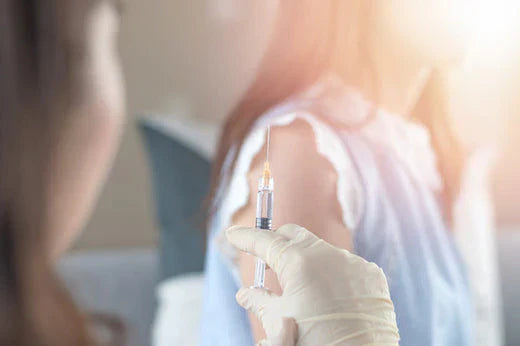Have you ever wondered how many types of HPV are there and whether they are all linked to cervical cancer? And more importantly, is it possible to prevent HPV infection? Let's answer these questions together.
What is HPV?
Human Papillomavirus (HPV) is a common group of viruses that affects both men and women. According to the WHO, in 2019 it caused about 620,000 cases of cancer in women and 70,000 cases in men (1).
People mainly transmit it through skin-to-skin contact, including sexual contact. Within this, it affects the skin as well as the genitals, anus and throat. Some types of HPV can cause warts on different parts of the body, while others can cause certain types of cancer, such as cervical, vaginal, penile and throat cancer, among others (1,2).
Now, if you're wondering how many types of HPV there are and which ones are most dangerous, here's the information:
How many types of HPV are there, and how are they classified?

There are more than 100 different types of HPV (2). And their main categories are (3,4):
- Low-risk HPV:
These usually cause warts on the skin (hands and feet) or genitals. Although these warts can be annoying and aesthetically unpleasing, they do not have a significant risk of developing into cancer. Types 6 and 11 are examples of low-risk viruses that cause most genital warts.
- High-risk HPV:
These types can lead to the development of cancer in some people who have persistent infection. Types 16 and 18 are the most commonly associated with this complication. However, 31, 33, 35, 45, 52 and 58 are also considered high risk.
Who is at risk of HPV infection?
In addition to knowing how many types of HPV are there, it is important to understand who is most at risk of infection. The answer is that anyone sexually active can get HPV, even if they have only one sexual partner in their lifetime. Transmission of the virus can occur through penetrative and non-penetrative sexual encounters, oral sex, anal sex and the use of sex toys (2,4).
The risk increases with the number of sexual partners, the presence of other STIs and the lack of use of protective barriers such as condoms (2,4).
How many types of HPV are there: know their symptoms
Although infection is common, many people have no symptoms and may not know they are infected. However, the most common signs are:
- Genital warts: these include warts in the anus, vulva, vagina, penis or the skin surrounding the intimate area. They may appear singly or in clusters. They may cause pain or itchiness, and in some cases, sexual activity may injure them, leading to post-coital bleeding (2,5).
- Other warts: include those that occur on hands, feet and areas that are commonly shaved, such as the legs (3).
- Cervical changes: only visible by Pap smear (2).
- Symptoms suggestive of cervical cancer: such as bleeding or pain when having sex and bleeding between periods (1). It is important to note that vaginal dryness is not usually a warning symptom.
Doctors mainly diagnose HPV by visually inspecting the warts. However, a Pap test can identify abnormal cells in the cervix that suggest HPV infection. You can do this test at any sexual health clinic (2,5).
Types of HPV: how to avoid infection
To reduce your risk of HPV infection, consider the following recommendations (1,2,3,4):
- Get vaccinated against HPV. The vaccine is available and recommended for children and young adults.
- Use a barrier method when having sex. Although it does not completely eliminate the risk, it is one of the most recommended types of contraceptives in this case.
- Participate in regular cervical cancer screening as recommended by your doctor.
- Limit the number of sexual partners.
Now you know how many types of HPV are there and what kind of diseases can cause. The next step is to put preventive measures into practice and discuss any unusual symptoms with your doctor.
Referencias Bibliográficas
- WHO. Human papillomavirus and cancer [Internet]. 2024 [cited 2024 May 10] Avaliable from: https://www.who.int/news-room/fact-sheets/detail/human-papilloma-virus-and-cancer
- NHS. Human papillomavirus (HPV) [Internet]. UK: NHS; 2022 [Cited 2024 May 10] Avaliable from: https://www.nhs.uk/conditions/human-papilloma-virus-hpv/
- Luria L, Cardoza G. Human papillomavirus [Internet]. EE.UU.: NHI; 2023 [Cited 2024 May 10] Avaliable from: https://www.ncbi.nlm.nih.gov/books/NBK448132/
- Cancer Reasearch UK Does HPV cause cancer? [Internet]. UK: CR; 2024 [Cited 2024 May 10] Avaliable from: https://www.cancerresearchuk.org/about-cancer/causes-of-cancer/infections-eg-hpv-and-cancer/does-hpv-cause-cancer
- NHS. Genital warts? [Internet]. UK: NHS; 2023 [Cited 2024 May 10] Avaliable from: https://www.nhs.uk/conditions/genital-warts/
You May Also Like

JOIN US AND GET 10% OFF
Sign up to our newsletter to access free resources, advice and support.















